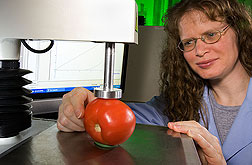Genotyping for Tomato Quality

ARS plant geneticist John Stommel, at the Genetic Improvement of Fruits and Vegetables Laboratory in Beltsville, Maryland, is identifying genes in wild species of tomato that might increase the quality of cultivars.
Within these tomato genotypes, Stommel is identifying multiple locations-or loci-where genes related to specific traits are found. These loci include gene variants that may be exploited to enhance fruit quality attributes related to tomato fruit firmness and rot resistance.
Firmness is important for tomato fruits grown for both fresh-market sales and processed foods, because it helps them withstand the rigors of harvest and shipping.
Stommel is identifying the number and location of these genes of interest within the 12 chromosomes of the wild species' genomes. "Some traits are controlled by single genes and are simply inherited," says Stommel. "But others are controlled by numerous genes and are called 'quantitatively inherited traits.'"
Stommel seeks links between a trait and the loci where its governing genes occur, and then uses statistical analysis to assess the relationship between phenotype and genotype.
Using diverse tomato breeding lines, Stommel evaluated fruit firmness attributes through both compression and puncture tests. The results from both tests suggested that superior genotypes could be produced by combining, in one genotype, the genes that positively influence firmness.-By Rosalie Marion Bliss, Agricultural Research Service Information Staff.
Agricultural Reasearch magazine, August 2008 Complete Article
